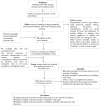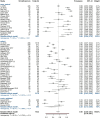Importance of vitamin D in acute and critically ill children with subgroup analyses of sepsis and respiratory tract infections: a systematic review and meta-analysis
- PMID: 31122993
- PMCID: PMC6538078
- DOI: 10.1136/bmjopen-2018-027666
Importance of vitamin D in acute and critically ill children with subgroup analyses of sepsis and respiratory tract infections: a systematic review and meta-analysis
Abstract
Objectives: To estimate the prevalence of 25-hydroxyvitamin D (25(OH)D) deficiency and investigate its association with mortality in children with acute or critical conditions.
Design: Systematic review and meta-analysis of observational studies.
Data sources: PubMed, OVID, Google Scholar and the Cochrane Library searched until 21 December 2018.
Eligibility criteria: Studies of children hospitalised with acute or critical conditions who had blood 25(OH)D levels measured.
Data extraction and synthesis: We obtained pooled prevalence estimates of 25(OH)D deficiency and ORs for mortality. We calculated 95% CI and prediction intervals and investigated heterogeneity and evidence of small-study effects.
Results: Fifty-two studies were included. Of 7434 children, 3473 (47.0%) were 25(OH)D deficient (<50 nmol/L). The pooled prevalence estimate of 25(OH)D deficiency was 54.6% (95% CI 48.5% to 60.6%, I2=95.3%, p<0.0001). Prevalence was similar after excluding smaller studies (51.5%). In children with sepsis (18 studies, 889 total individuals) prevalence was 64.0% (95% CI 52.0% to 74.4%, I2=89.3%, p<0.0001) and 48.7% (95% CI 38.2% to 59.3%; I2=94.3%, p<0.0001) in those with respiratory tract infections (RTI) (25 studies, 2699 total individuals). Overall, meta-analysis of mortality (18 cohort studies, 2463 total individuals) showed increased risk of death in 25(OH)D deficient children (OR 1.81, 95% CI 1.24 to 2.64, p=0.002, I2=25.7%, p=0.153). Four (22.0%) of the 18 studies statistically adjusted for confounders. There were insufficient studies to meta-analyse sepsis and RTI-related mortality.
Conclusions: Our results suggest that 25(OH)D deficiency in acute and critically ill children is high and associated with increased mortality. Small-study effects, reverse causation and other biases may have confounded results. Larger, carefully designed studies in homogeneous populations with confounder adjustment are needed to clarify the association between 25(OH)D levels with mortality and other outcomes.
Prospero registration number: CRD42016050638.
Keywords: intensive care; meta-analysis; mortality; paediatric; prevalence; respiratory tract infections; sepsis; systematic review; vitamin D.
© Author(s) (or their employer(s)) 2019. Re-use permitted under CC BY. Published by BMJ.
Conflict of interest statement
Competing interests: None declared.
Figures





References
Publication types
MeSH terms
Substances
Grants and funding
LinkOut - more resources
Full Text Sources
Medical
